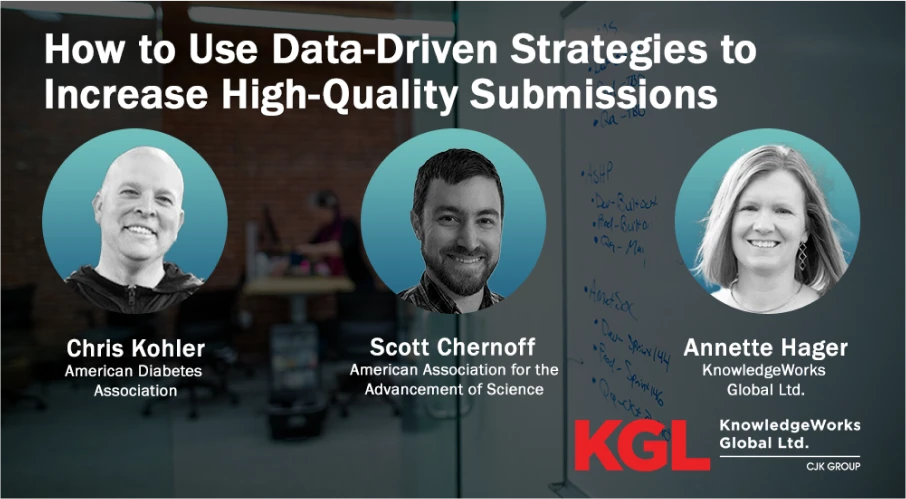Last month, customers, friends, and guest speakers from across the globe convened once again for our annual KGL PubFactory Virtual Series. During the course of the three-day event, a packed and topical agenda enabled the scholarly publishing community to share valuable insights, learnings, developments, advice and trends with their peers.
One of the highlights of the Industry Day (day two) program was a fascinating discussion chaired by KGL Senior Consulant, Annette Hager, entitled, Data-Driven Strategies for Increasing High Quality Submissions. This session explored practical ways in which publishers can integrate bibliometric and citation data into their editorial strategies in order to attract both larger volumes of submissions and, perhaps more importantly, higher quality submissions.
Joining Annette on the panel were two guest speakers offering two very unique perspectives from the world of journal publishing. Scott Chernoff, Product Development Manager at the American Association for the Advancement of Science (AAAS), oversees its Science Partner Journal (SPJ) program, an OA initiative designed to launch new journals with partner organizations, which currently has 14 journals in its portfolio. Also speaking was Christian Kohler, VP and Publisher, Professional Publications at the American Diabetes Association (ADA), which produces four journals in addition to books, compendia, podcasts, e-newsletters, and more.
A Competitive Edge
Setting the scene, Annette briefly described the current publishing environment: “Our industry is in a period of transformation and it has been for quite a while. In the current environment, journals that publish more content are much more likely to succeed than those which publish less. But put simply, publishing more isn’t the goal. The idea is to publish more high quality content to advance your journal’s reputation and impact.” In an increasingly competitive, globalized journal market, attracting the highest quality research is becoming increasingly difficult, and having citation data and analysis at your fingertips can give journals real competitive advantage.
Addressing “The Dip”
On the challenges the AAAS faced initially upon launching its new journal program, Scott said: “There were certainly some growing pains. Having launched in 2017 the program grew from two journals in 2018 to 11 in 2020 and the staff resources at AAAS were constrained, so our focus was largely on operational needs and less so on the editorial status of the journals. We recognized that there were some journal-specific challenges, and while the number of submissions were increasing, the number of accepted submissions were not. In general, this was due to not enough high-quality submissions coming in, so we wanted to identify ways to grow this number.”
According to Christian, in the field of diabetes the number of journals being published around the world had recently risen sharply from 89 to 145. He originally suspected that this, coupled with OA mandates, was starting to have an effect on submissions coming through for the ADA’s journals. He commented: “The impetus for us in originally reaching out to KGL was to get more submission-related data and to analyze what was causing this dip. Our initial analysis revealed that the decrease in submissions wasn’t necessarily down to OA mandates, but we wanted to try to pinpoint any specific funders, institutions or regions where submissions were falling.”
Delving Into The Data
The next step was to determine whether increased competition may be impacting the ADA submissions pipeline and to identify potential solutions: “We now need to find out if there are authors, departments and institutions who would traditionally publish in our journal but who are now, for whatever reason, publishing elsewhere, examining the citations of those papers and the impact factors of the competitive journals.”
The AAAS started working with KGL in 2020 and together they formulated a citation analysis plan, benchmarking the SPJ journal program, identifying its strengths and weaknesses, conducting competitor analysis, and leveraging the granular citation data available on the most established competing journals. “As a result of this analysis we were able to start tackling some of these challenges, examining certain topic areas that were underrepresented in our journals, and where our editorial boards might need further development. It revealed countries and institutions that were producing quality research and identified specific international collaborations and groups that could be targeted, while also suggesting topics of interest to our community and showing gaps in topic areas currently covered by our journals,” said Scott.

A Wealth Of Benefits
“Overall, having access to this citation data has delivered strong results, enabled us to reach out to new editorial board candidates, strengthened the quality of our peer review pool, helped us to increase our output in additional topic areas and helped to grow our journal’s readership and citations,” Scott concluded.
For the ADA, usage and citation metrics are playing an increasingly important role, forming an integral part of the organization’s overall strategy as they look to transition their journal program to gold OA by late 2025: “We are using bibliometric and citation data in several ways – from identifying emerging topics and the most relevant topic categories to analyzing submission trends, contributors and opportunities, from identifying technical glitches and issues to assessing the impact of Open Access. We are able to use citation data from sister journals to inform what and who we publish in other journals in the family, and across our books and multimedia program too,” concluded Christian.
Click here to watch the full session. To explore some of the other panel discussions and presentations from this year’s KGL PubFactory Virtual Series, visit our Industry Day event page.





